
52 minute read
The Postmodern Revolution & Anthroposophical Art
by David Adams
As is well known, the late 1960s marked the beginning of a wave of social, ecological, and cultural change that swept the world. The generation reaching adulthood in those years protested against the existing order and sought to develop new social and cultural forms. An alienated attitude critical of establishment values was widespread in this rebellion, which looked for some kind of universal renewal of modern civilization.
If we look for a background to these developments in Rudolf Steiner’s research which informs anthroposophy, we focus first on the opening of the century. The year 1899 marked the end of an age of spiritual darkness, Kali Yuga, which lasted five thousand years. Now humanity could begin again to attain a conscious awareness of spiritual phenomena. Steiner saw this evolutionary development as a consequence of the “Mystery of Golgotha,” the great sacrifice of the Christ. He also observed that the 33 ¹/ ³ year life-rhythm of Jesus Christ continues to influence events. Moving into the twentieth century, it brings us to 1933, when Steiner said human beings would begin to have experiences of the reappearance of Christ within the etheric realm, along with counter-measures which led to the second world war. In The Spiritual Event of the Twentieth Century Jesaiah Ben Aharon shared his own research into the “Christ Event of the Twentieth Century,” which developed in stages beginning in the twelve years from 1933 to 1945.[1] Ben Aharon suggests that we look at these twelve years again after another 33 ¹/ ³ years, that is, the period 1967-1979, when many deeper changes of the Christ Event began to occur.
There were human souls in the spiritual world during the 1933-1945 events who were approaching a new birth. Born just after the war, this generation began to reach their ego maturity around 1966-68. These souls of the “Baby Boomer” generation helped to lead significant social, ecological, political, cultural, and spiritual transformations of the last third of the century, working out of unconscious will forces and semi-conscious heart forces.
Even without anthroposophical insights, the period 1967-1968 shows the beginning of a fundamental change in the visual arts, the shift from modernism to postmodernism. Anthroposophists working in the visual arts have mostly ignored this transformation in mainstream art for more than thirty years now. It is past time to begin taking a look at it—especially if we want our art to relate to the contemporary world and take its place within the artistic dialogues and developments of our time.
Postmodern art is far too large a topic to cover here, but I want to make a beginning by looking at the key period of the late 1960s. Even this is a large topic, so I will only present the initial period of these artistic changes, symptomatically, through the work of a single American artist. It is appropriate to focus on an American artist, since with each of the two world wars, America assumed a new role and responsibility for the inner development of western (if not global) human culture, a role in which Europe had largely failed. First we must recall briefly the context of that time in the artworld in New York City.
The New York Context
Abstract Expressionism, which emerged just after World War Two in the later 1940s and 1950s, was the first major artistic style to originate wholly within the United States—and then be imitated in Europe. The New York School artists experimented with the spontaneous, the indeterminate, the dynamic, the open, and the unfinished. The development of their painting has been classified (somewhat arbitrarily) into two main tendencies: gesture (or “action”) painting and color-field painting.
Gesture or “action” painters such as Jackson Pollock and Willem de Kooning spontaneously organized their canvases as open, expressive accumulations of direct painterly ”gestures,” forming a unified “allover” image that seemed to expand dynamically beyond the framing edge (fig. 1).
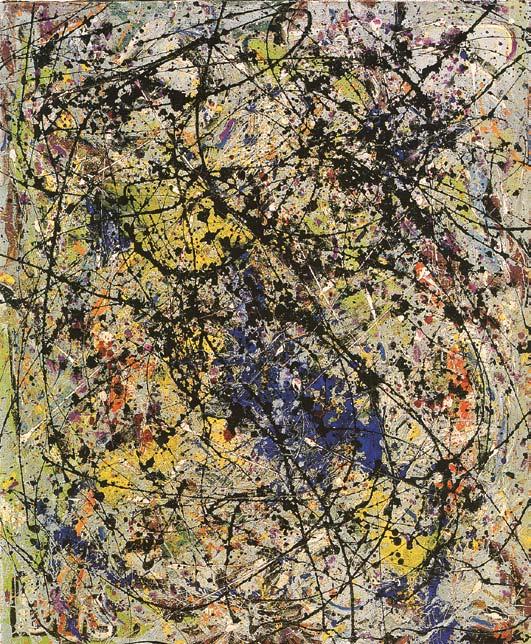
Fig.1 - Jackson Pollock. Reflection of the Big Dipper. 1947, oil on canvas 43¼ x 16¼”.
Color-field painters such as Mark Rothko and Clyfford Still, who developed slightly later, concentrated on the overall effect of the painting as a single shape, presenting more refined, unified, and expansive optical textures or “fields” (fig. 2). They wanted to maximize the visual impact of specific colors and found that, to do so, they had to simplify or eliminate any other figures or symbols and apply the colors in large expanses that would saturate the eye. This was a more radical abandonment of the familiar structural basis of existing western art – that is, of the use of modulated dark and light values to produce the illusion of three-dimensional mass in space. Instead, the surface of the painting was treated as an active ”field” with a unified texture for an allover, “single image” effect.

Fig.2 - Mark Rothko. Orange and Yellow. 1956, oil on canvas, 91 x 71”.
A number of younger artists took up the color-field wing of Abstract Expressionism, eventually leading it toward simpler, flatter, and hard-edged forms. Different names were given to these later tendencies in painting (which continued into the 1970s and beyond), of which I will use Post-Painterly Abstraction. The Post-Painterly Abstract artists used a hard edge; a more anonymous execution; even, clear, bright colors; and often a feeling of openness and simple clarity.
Clement Greenberg’s Art Theory
New, properly non-painterly styles first emerged outside of the New York School: the hard-edged abstraction of Ellsworth Kelly, Frank Stella, and Leon Polk Smith; and the stained colorfield abstractions of Morris Louis, Kenneth Noland, and Jules Olitski. Louis and Noland in Washington, DC accepted the influential critic Clement Greenberg as their advisor and promoter. He introduced them to the work of Helen Frankenthaler, who had thinned her paint so it soaked directly into the canvas as a color area, helping eliminate the visual distinction between a foreground and a background.
One of the basic ideas of Greenberg, the most important art critic and theorist to emerge since the war, was that in the modern era each of the arts has been impelled toward “self-definition,” toward what is unique and irreducible in their particular medium. Uniquely characteristic of painting are “the flat surface, the [rectangular] shape of the support, the properties of pigments” [i.e., color]. Most important was flatness, for it alone is “unique and exclusive to pictorial art.” In its urge for purity, painting was required to steadily purge itself “self-critically” of all representation and illusion, of every effect that was not essential to the medium of painting. It was this progressive purification that gave rise to the changes of style in modern art.[2]
There are some similarities to Greenberg’s idea in statements of Rudolf Steiner. For example, in The Arts and Their Mission he criticizes the traditional practice of using spatial (linear) perspective to create the illusion of spatial depth in painting. “This rejects at the outset the most important material the artist has, for he does not create in space, he creates on a flat surface, and it is quite ridiculous to want to experience the thing spatially when one’s basic material is a flat surface.”[3] He also refers to color as the proper or fundamental element of painting.[4]
Greenberg was the leader of a general attack on de Kooning-style gestural painting in the early 1960s. Loose, gestural brushwork was condemned because it denied pictorial flatness and suggested a degree of illusionistic space and “atmosphere.” Also forbidden was structure based on contrasts of light and dark, which tended to create illusionistic space. Even thick-textured paint produced more of a sculptural quality and detracted from the purely “optical” effect of color. Greenberg urged Louis and Noland and other painters to suppress painterly details and treat the entire picture as an open field of flat color-shapes, using thin colors stained directly into the canvas.
Frank Stella was probably the outstanding figure of this group. His “black-stripe” paintings seemed to use the physical depth of the canvas as a kind of module (fig. 3). It dictated the width of his stripes. These were separated by thin strips of bare canvas that called attention to the physical picture surface. The rectangular shape of the stretcher determined the concentric and symmetrical composition of the stripes. Shape and thickness of canvas seemed to dictate the picture’s configuration, i.e., it seemed to refer only to itself as an object. Stella aimed to carry to its ultimate solution the formalist view of the central problem of modern art – how to articulate the reality of the picture as a flat, two-dimensional thing. His blunt black and later industrial and metallic colors formed large, clear stripe-patterns that were instantly perceptible, and the in-between bare-canvas lines flattened the pictorial space to an unprecedented degree, asserting the physicality or objecthood of the canvas.

Fig.3 - Frank Stella. The Marriage of Reason and Squalor (second version). 1959, black enamel on canvas, 90¾ x 132¼”.
Stella’s own formalist aesthetic was based somewhat more on the writings of painter Ad Reinhardt than Greenberg. Reinhardt had argued the purification of painting by eliminating everything that was not of and for painting, especially extra-aesthetic references to “life.” He wanted to purge art of everything but art, although he had a rather materialistic idea of the art object. He ridiculed the “transcendental nonsense, the picturing of a ‘reality behind reality’” of color field painters. Instead, he called for “pure painting [in which there] is no degree of illustration, distortion, illusion, allusion, or delusion.”[5]
Minimalism
The new style known as Minimalism first emerged as sculpture in the one-person shows of Donald Judd and Robert Morris in 1963. Minimal sculpture consisted of elementary geometric volumes or symmetrical, serial sequences of modular geometric volumes placed not on pedestals but directly on the floor or wall. They used non-relational design, uninflected surfaces with no signs of process, and colors that were simply those of the substances used, especially industrial materials (or paint). The emphasis was on literal objecthood and extreme physicality, but the design was based on preconceived ideas. The seemingly simple sculptures of Minimalism depended upon a lot of critical writing, mostly by the artists themselves, to explain why they were important.

Fig.4 - Donald Judd. Untitled (Ten Stacks). 1969, anodized aluminum.
Judd admired visual intensity or immediate impact in art and felt that no painting could hold its own visually against this new work in three dimensions that in 1965 he called Specific Objects. Also, he argued that working in actual materials like fiberglass, formica, plexiglas, chrome, plastic, and fluorescent lights had a specificity and power that painting lacked, especially when these new materials were closely related to the form of the artwork. Because of this, Judd announced, painting was dead and “had to go entirely.” This led to a series of 1966 debates: “Was painting dead and at its historical end?” Even the most minimal painted illusionism was seen as a distortion of the true nature of the object. Only with the perception of objects that existed to begin with in all three dimensions did the eye’s vision match what the mind knew to be true from experience.
For his own art, Judd began in 1964 focusing on relief, constructing metal boxes cantilevered off walls (fig. 4). Each element was an isolated Specific Object, yet also part of a mathematically-arranged pattern. Such “arrangement” avoided traditional composition, the use of major and minor elements ordered into a balanced, hierarchical structure. In Judd’s work all parts were equal. Judd felt that traditional composition reflected a larger idea of order, which diluted the immediate concrete experience of the piece by referring to something else exterior to the work of art as an object.
From the later sixties onward he concentrated on large floor pieces, often with perforated surfaces, to emphasize static immobility, simplicity, openness, and clarity (fig. 5). His extreme focus on the literal object was something new in sculpture.

Fig.5 - Donald Judd. Untitled. 1977, stainless steel and nickel, 4 nits, each 59 x 59 x 59”.
In contrast to Judd’s rejection of painting, Clement Greenberg had argued that the goal of advanced painting also was objecthood, accepting its essential qualities of flat canvas and color.
Robert Morris in 1966 called for a clearer distinction between painting’s optical (color) qualities and “sculpture’s essentially tactile nature.”[6] He also believed painting was outmoded and applied Greenberg’s goal of “reduction to essentials” to sculpture. What made sculpture unique, said Morris, was its literal, monolithic physicality, whose (physical) properties were scale, proportion, shape, and mass. To maximize these physical properties, he preferred simpler forms that could be directly apprehended as constant, known shapes: mainly regular polyhedrons, such as cubes and pyramids. He called them Unitary Objects. Sculpture also should avoid segmentation, color, sensuous surfaces, details, and inflection—anything that could be seen as spatially illusionistic or pictorial. Not only painting, but also pictorial sculpture was outmoded. Ironically, Greenberg didn’t like Minimalism, feeling it was contrived, “something deduced instead of felt or discovered.”[7] For Greenberg, the experience of modernist art was divorced from common, real, literal space and time. But the Minimalist sculptors used Greenbergian principles to move beyond Greenberg’s own opinions.
Because Minimalist sculptures were pre-planned and prefabricated (or arranged from prefabricated materials), minimal artists avoided the improvisational process of creation associated with Abstract Expressionism. The creative act was the artist’s idea, not the activity of construction. Carl Andre took a further step beginning in 1966 by arranging bricks and squares of metal in rectangles on the floor, aligned with the form of the room (fig. 6). “Rather than cutting into the material, I use the material as the cut in space,” he said.[8] His use of materials blended them into the space so that the sculpture loses much of its object-like quality. He even invited viewers to walk on them, further emphasizing the literal presence of the material. “I severed matter from depiction,” he claimed.
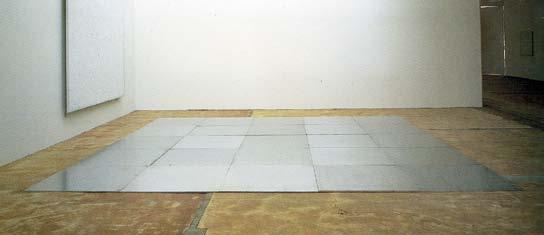
Fig.6 - Carl Andre. Aluminum Square. 1968, 25 aluminum squares, 3/8 x 197 x 197”.
Postmodern or Postminimalist Art
In addition to his concept of a progressive “self-definition” of each art, Greenberg asserted that the artist’s primary goal was to create art of quality. There was an importance to “aesthetic value and excellence for its own sake, as an end in itself.” [9] Thus, artworks were typically displayed as isolated, independent objects surrounded by white walls in galleries and museums. For Greenberg, the antithesis of modernist art was kitsch: “popular, commercial art and literature”—e.g., magazine covers, illustrations, ads, pulp fiction, comics, pop music, Hollywood movies. There could be no compromise in the struggle between authentic high culture and debased popular culture or entertainment. The idea that the work of art should be autonomous and self-sufficient within its own realm is a position labeled “formalism” and associated with modernist art. The primary enemy for Greenberg in the 1960s was Pop Art, which broke down the barriers between high art and kitsch, foreshadowing postmodernism.
Actually, there were no widely agreed-upon definitions of either modernism or postmodernism in the 1960s and 1970s – or even once postmodern art more widely emerged in the 1980s. At first, art historians treated postmodernism as a pluralist bundle of styles superseding modernist ones. Then a more sociological outlook proposed that a radical change had taken place, from an industrial society, which had generated modernism, to a postindustrial society that also gave rise to postmodern art.[10]
In philosophy postmodernism refers to the end of an epistemologically centered philosophy based on the efforts of a knowing subject to know truth by achieving a true mental representation of objective reality (the Cartesian subject-object dualism). It argues (among many other things) that there is no temporally invariant truth since human understanding is always historically-based (or “contingent”).
Modernism in art was characterized by qualities like autonomy, quality, and novelty. Art was felt to be universal and transcendent within its own special sphere (“art for art’s sake”). Viewers expected to react to the latest formal innovations with the “shock of the new.” By contrast, postmodernism valued social relevance. It felt art should engage its specific social context and that nothing really new was still possible in art. Viewers should expect a “shock of recognition” when seeing familiar aspects of their daily world used for works of art. Modernists believed a work’s content inhered in its innovative and creative form, while subject matter was more or less incidental. Postmodernists emphasized subject matter or content in art.
Postmodernists initially took their cues from architecture, which earlier had launched a sustained attack on the modernist International Style, an attack initiated by Robert Venturi’s 1967 book Complexity and Contradiction in Architecture. Postmodernist architecture called for multiplicity, inclusiveness, and eclecticism instead of the formalist uniformity and exclusiveness identified with the International Style. It repudiated Modernism’s obsessions with the new, and it often rehabilitated decorative motifs from premodern styles, combining them with modernist motifs. Although this soon became primarily a kind of appropriation and eclectic mixing of historical styles (historicism) that did not develop further, it seemed new and fresh at the time.
Also prominent in postmodern thought was the idea that the modernist way of carrying art to extremes to achieve the next new, innovative style had become too commonplace in the art world. It had become a cliché, and art had gone as far as it could go. The avant-garde was dead. A large part of the public no longer responded in outrage to the latest novel development in art. Modernist art had become institutionalized and “official” as well as so popular that it could increasingly be considered another form of mass cultural entertainment or decor.
Postmodernists also had revised attitudes toward popular culture (or kitsch). In the second half of the twentieth century, popular culture (including the mass media and mass consumerism with its accompanying advertising) had grown so pervasive and powerful that it had become like the “second nature” of modern life. Art could no longer ignore it. By the 1980s the art of those who mixed artistic mediums, embraced diversity, and looked for inspiration in everyday, common imagery, the mass media, past art, and consumer commodities, seemed much more vital than modernist art. (See for example fig. 7, which also suggests the revival of painting that took place.)

Fig.7 - David Salle. Muscular Paper. 1985, acrylic and oil on canvas and printed fabric, 98 x 187½”.
Many young artists had ceased to believe in the futuristic visions of progress from the modernist era and began in their art to “quote” or recycle images and forms from past art and the mass media. Appropriation, as this practice came to be known, became the primary sign of postmodernist art. The new art declared the end of the modernist, formalist approach and introduced an art of replication and mixing of previous styles (often called “neo” or “retro” styles), of appropriation and simulation. Along with this was a denial of originality, experiment, innovation, and invention – even of the importance of the role of the artist as creator.
Above all, postmodernists rejected modernist claims to universality. Observing how such ideas had been used politically in the past to reinforce exploitative power relations, they were suspicious of any kind of universal guiding principles or idealist programs. They dissolved every kind of totalizing explanation and hierarchy. They asked: Wasn’t this modernist culture just the creation of Western middle-class whites and heterosexual males? Instead, Postmodernist artists have stressed differences in class; gender; local, regional and national character; race and ethnicity; and history, culture, and current events—the particular and the multicultural. They also began to analyze or “deconstruct” the practices and institutions of the art world itself.
It was especially Minimalist art that was attacked by the early postmodernists. In fact, they were called postminimalists at first, and some still argue that the postminimalists were just the very last gasp of modernism rather than the first breath of postmodernism. To become more thinglike, minimal sculpture had eliminated all internal relations or variations that might call the viewer’s attention away from simple thingness or objecthood. However, this led the viewer to pay attention to relationships between the minimal sculpture and its surroundings. Thus, changes in the environment, lighting, and position of the viewer (or different viewers) were experienced as components of the work. Because of this, it was pointed out that the Minimalist artwork lacked self-sufficiency. Critic Michael Fried maintained in a much-debated 1967 article “Art and Objecthood,” that, because the viewer is included in the “situation” of minimal sculpture, it is “theatrical,” like a stage with the viewer as an actor, experienced in time.[11] It could also be said that, as the art object in space grew simpler, the focus of attention began to shift more to the experiences of the subject (viewer) in time.
The postminimalists embraced Fried’s idea of “theatricality.” If time was implicit in the way minimal sculpture was experienced, these later artists made temporal experience and theatricality thoroughly explicit – in fact, the only possible way of experience, especially in new forms of film, video, and performance art. Postminimalists dematerialized the object (process art and conceptual art), spread it out into its surroundings (process art, installation, and earth art); formed an idea and presented it as a work of art in itself (conceptual art); and employed their own bodies in performance (body art and performance art). (See fig. 8.)
The new postminimalist artists experimented in four fundamental directions based on polarities of mind and body as well as time and space (which can be seen to form a kind of defining cross of incarnated existence). Temporary situations in actual space and real time dispensed with the conception of art-as-a-precious-object, existing in a special, timeless “art space” different from ordinary space. It could be said that the Minimalists had tried to reduce art to purely an object, but discovered they couldn’t eliminate the human subject, the other side of the subject-object polarity that delimits human experience. So the postminimalists accentuated the subjective.
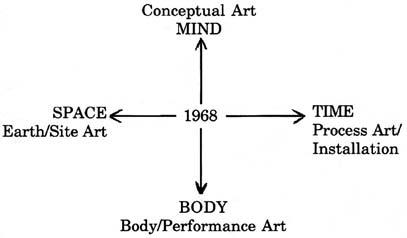
Fig.8 - Four Directions of Postminimalist Art.
Postmodernism generally represents an attempt to open out the enclosed aesthetic world of modernism to the real world so that aesthetic experience can be reintegrated with everyday life. Thus, the postminimalists moved their art into the world, outside of elite, protected gallery and museum spaces. Likewise, the postminimal denial of art-as-object was joined with a growing revulsion against the commodification of art. Many artists, disgusted by the art market, purposely made art that could not be bought or sold: piles of dirt, trenches dug in the desert, conceptual art consisting only of verbal statements. However, they eventually discovered that there was no art so extreme or inaccessible that some collectors would not still pay handsomely for it.
During the late 1960s many alienated young people and artists “dropped out” of mainstream society to seek a new way of life. The counterculture arose to oppose the tradition of Western culture marked by rationality, work, duty, maturity, and success. A disgust with the past and despair for the future compelled disaffected young people to look only to the present. Thus, in terms of social context it is not surprising that artists rejected art-as-object-for-the-ages and instead favored the direct, present process of art making over the finished product, often using perishable materials or no materials at all.

Fig.9 - From Modernism to Postmodernism.
The succeeding artists of the 1970s, leading into postmodernism proper, generally responded with more irony and with radical, irrational, unconventional, absurdist, or perverse experiments in art. A variety of styles and approaches arose and are still arising, especially under the category of digital or media art (see fig. 9). Having progressively “purified” itself down to color field painting and then minimalist sculpture, modernist art passed through the “eye of the needle” around 1967-68 to emerge into a new profusion or “pluralism” of “postmodern” styles and movements.[12]
Robert Morris
I want to introduce postminimalist or early postmodern artwork symptomatically through the creations of one artist, Robert Morris. In many ways he is the ultimate postminimalist artist, having gone through almost every postminimalist mode as well as Minimalism: Performance, Body Art, Process Art, Earth Art, Installations, Conceptual Art, Sound Art, film, and, later, Neo-Expressionism.
He had already in 1961 been concerned with the problem of how to get the process to show in the product. In 1961 he created Box with the Sound of Its Own Making, a walnut box containing a 3-hour tape recording of the sounds of its own fabrication. His I-Box of 1962 clearly made the minimalist box “theatrical.” When the chalky pink door of this large, Minimalist-looking wooden box was opened, there was a literal “I” inside in the form of a full-size photograph of the naked Morris with a twinkle in his eye. That purposely trivialized the Abstract Expressionist idea of artists inscribing or revealing their true I in their artwork. When the case was opened, there really was nothing inside but another outside. Morris was playing with how we think of our “self” hidden within our body.
Morris explored a number of witty variations on the nature of the Minimalist object. He noted that when internal, intimacy-producing relationships were taken out of a work, they were transferred to the context in which the work was shown. Thus, the unitary object is carefully placed into its environment in real three-dimensional space. He created a number of his “Unitary Objects” from off-white fiberglass that the viewer knew to be hollow, again undermining their solid objecthood. In the untitled sculpture shown in figure 10 the slit in the block allows a slice of light to escape from the fluorescent-light interior, just where one would normally expect shadow.
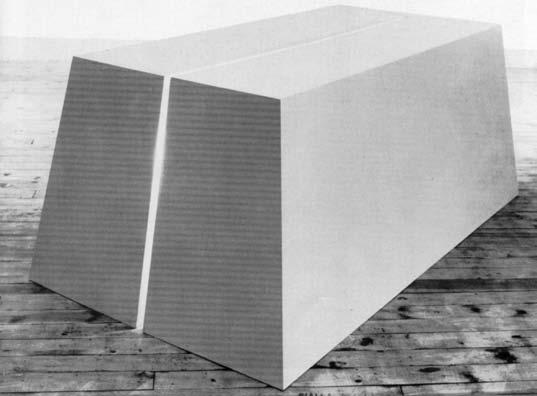
Fig.10 - Robert Morris. Untitled. 1966, fiberglass with light, 91 x 122 x 229 cm.
In the late 1960s he developed many variations to his Unitary Objects in both form (cylinder, oval, tapered square, wedge, “L,” and “H”) and materials (steel mesh, aluminum, wood, granite, fiberglass, etc.). The materials chosen typically compromise the serial units by making them more optically complex. His subversion of the object was most extreme in a 1965 piece consisting of four plexiglas-mirror-covered wood boxes that more or less dissolved in their reflections of the environment (fig. 11). It created a paradox and invited the viewer’s movement. Having disposed of Minimalist pretensions, Morris proceeded to explore artwork in each of the four basic new types, also using his work in these new forms to comment on previous notions of art.

Fig.11 - Robert Morris. Untitled. 1965, 4 mirrored boxes, each 21 x 21 x 21”
Conceptual Art
Minimal artists based their works on preconceived ideas intended to produce the most objectlike of objects. At the end of 1960s artist began to consider the preconceived ideas behind Minimalist objects for their own sake and to present them in verbal form as independent works of art. This came to be called conceptual art, and Morris was a pioneer in this as well.
In Morris’ 1963 Card File, a series of plastic-encased cards documented the process of compiling the file. This work anticipated both process art and conceptual art. It becomes complex to think about the work when the work itself is its own description (as a process). This work also mocked the traditional idea of the artwork as the sum of the intentions and actions of the artist. In another conceptual art project in 1968, Morris sent a telegram proposing to “re-do” the Chicago Fire of 1871.
Process Art
As he continued to explore form, Morris also turned to what he considered its dialectical opposite, matter. He began to manipulate materials whose “forms” were flexible and open-ended, especially soft materials that would move away from traditional ideas of structure. Influenced by Joseph Beuys and Claes Oldenburg, he chose gray felt for many of these works, because he could preconceive cutting it according to geometric progressions. Once the cutting was done, however, the arrangement of the felt was shaped by the process of gravity. The resulting form could never be predicted or final, and it changed with time and new installations.
In a 1968 essay Morris argued that Minimal Art was not as physical as art could be because the ordering of its modular or serial units was not inherent in their material. Rather, the process of a work’s “making-itself” had to be emphasized.[13] Thus, this new, still more literal art focused on matter and the action of gravity upon it. Morris argued that the minimalist unitary object was related to its surroundings in a traditional figure-ground relationship and was thus “terminally diseased.” The cure was to base three-dimensional art on “the conditions of the visual field itself,” to replace the discrete object (for a discrete subject) by installed “accumulations of things or stuff.”[14]

Fig.12 - Robert Morris. Untitled (Tangle). 1967, felt, 264 pieces.
In these works of “process art” accumulations of soft materials spill across the floor into the viewer’s space and colonize more and more of the gallery floor space (fig. 12). His installation “Threadwaste” from 1974 filled the entire gallery floorspace with an expansive heap of threadwaste, mirrors, asphalt, aluminum, lead, felt, copper, and steel. Random piling, stacking, and hanging gave passing form to the material, and these installations were sometimes called “scatter pieces.” Rather than preconceiving a clear definition, this form of sculpture depended on real time and even on chance occurrences, requiring the viewer to participate, to “be there and to walk around the work.” It was essentially theatrical and soon evolved into what we refer to as installation art today.
Earth Art
In 1968 Morris exhibited an installation titled Earthwork, composed of a pile of another disordered material: soil. From that it was only a short step outdoors into Earth Art. Thus, two new forms arose: outdoor earth art and indoor installation art.
Because minimal sculptures lacked internal relationships and articulated their outer limits so emphatically, they pointed to their surroundings beyond. Thus, postminimalist Earth Art sculptors began to take into account the sculpture’s site and overall “situation.” One such change was to make work outdoors. Nature tended to be a more appropriate site for these spreading artworks than the contained, four-walled gallery. Like the materials of Process Art, most substances found in nature were impermanent, indeterminate, and changeable. In a piece realized several times between 1967 and 1973, Morris worked outdoors in even more “formless” medium – steam (fig. 13).

Fig.13 - Robert Morris. Steam. 1971-74 (1967 original), steam outlets under bed of stones outlined with wood, W. Washington Univ., Bellingham.
Minimalist sculpture had still been “commodity art” (precious objects for sale) – but how could you sell steam? In a later, larger-scale project of 1979 in King County, Washington, he reclaimed an abandoned gravel pit, a site of ecological abuse, shaping concentric terraces and slopes to form a kind of amphitheater (fig. 14). From within, only the sky is visible.
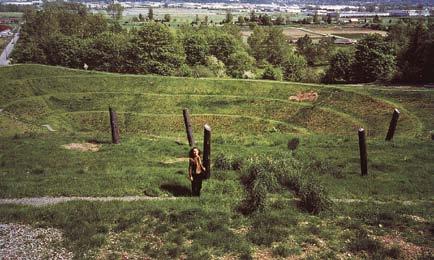
Fig.14 - Robert Morris. Untitled. 1979, reclamation project, Johnson Pit No. 30, King County, Washington, 3.7 acres, earth, tree trunks, tar.
Performance Art
Another new art form was body art (or, as it is more commonly known today, performance art), which carried theatricality to an extreme in “sculpture” where artists (at first) used their own bodies as the material of their art, performing elementary movements whose simplicity was inspired by minimal art or perhaps the artist’s biography or artworld issues. Morris created and performed in a number of dance-like performance pieces. In these performances he did not entirely neglect undercutting modern painting either. In his 1965 work, Site, a large white wooden cube played the sound of a jackhammer drill as Morris entered in plain white workman’s clothing wearing a mask of his face (made by artist Jasper Johns). This emphasized the work and “action” of creating art, an ironic reference to Abstract Expressionism. Three 4 x 8’ sheets of white plywood were grasped, turned, and shifted to reveal the reclining Carolee Schneeman, nude in white make-up, against a fourth panel in the pose of Edouard Manet’s 1863 Olympia, a famous touchstone of early modernist painting for its unprecedented flatness (fig. 15). But here the scene was brought out into three actual dimensions, until Morris’s dance with plywood sheets gradually hid her again. The performance was an absurd acting-out of modernist cult of the flat picture plane (which largely began with Manet). It also referenced the “white cube” environment of typical gallery and museum exhibition spaces that reinforce the modernist idea of the work of art as existing in self-referential isolation.
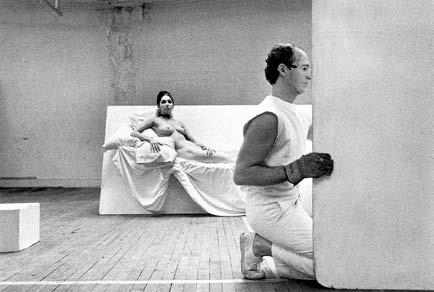
Fig.15 - Robert Morris. Site. 1964, performance with Carolee Schneeman, NYC.
One other example of a Morris performance was Waterman’s Switch of 1965, performed with dancers Lucinda Childs and Yvonne Rainer (fig. 16). This presentation in four segments lasted 17 minutes. Foam-rubber rocks were rolled on stage and bounced around to a recording of rolling boulders. After a blackout, Childs dragged a set of gray plywood tracks to the center, where, as a Verdi aria played, Morris and Rainer, wearing only mineral oil and locked in an embrace, began slowly traversing the tracks, shadowed by Childs in an outsized man’s suit unwinding a ball of twine over her shoulder as she moved. A series of similar symbolic movements ensued, sometimes incorporating elements of recorded sound or film, but generally dealing with the same themes of physical struggle, stones and boulders, and a labyrinthine stringing of the twine—almost like a musical theme-and-variations.
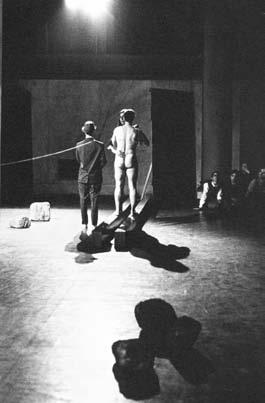
Fig.16 - Robert Morris. Waterman Switch. 1965, performance with Lucinda Childs and Yvonne Rainer, Buffalo, NY.
All of these new, postminimalist/postmodern forms of art denied and tried to avoid fixed objecthood in art. The acts of conceiving and placing the pieces took precedence over the “object quality” of the work. Many other artists have worked with these new forms in a great variety of types of expression.
Preliminary Anthroposophical Commentary
Where would anthroposophical art stand in relation to the issues of modernism versus postmodernism?
I mentioned that some of Rudolf Steiner’s statements seem to support the formalist, Greenbergian ideas of a focusing of each art form on its own unique, essential qualities – for example, focusing painting on flatness and color. There are also his comments on sculpture remaining true to the form tendencies of particular materials, e.g., concave forms with wood and convex with stone. Other comments reinforce the formalist idea of the work of art as autonomous and self-referential. For example: “In its inherent element, every art becomes both content and form.”[15] Or he speaks of “the super-earthly character of the miniature world of art.”[16] Or “...the artistic impression depends solely and entirely upon what confronts us in the picture, and makes itself best felt when we pay no attention at all to anything but what speaks from the picture itself. The inhabitant of Mars would therefore really be the best observer from a purely artistic point of view.”[17] In apparent opposition to the very idea of conceptual art, Steiner also said the following: “You can only think afterward about artistic forms. An artist does not understand them first, does not create from concepts and ideas.”[18]
However, still other Steiner statements seem to point in the direction of postmodernism, although it wouldn’t really come into being until more than forty years after his death. First, he supported liberating art from galleries and museums so that it can play a role in the rest of life: “Beauty must not remain captive in museums. Step by step we must work for its release.”[19] Or: “Art is very frequently severed nowadays from the general life of culture and civilization, and treated as though it were something that lives apart. This, too, is wrong.”[20] Steiner said that in the future the visual arts must become more of a musical experience, more like the performing arts, and vice versa. Do not the postminimalist forms bring an element of time and performance to the “essential object” that was the center of the previous modernist aesthetic – as well as a musical kind of “theme-and-variations” approach to composition? In the de-emphasis on the art object (on its “objecthood” and formal qualities), the emphasis shifted more to the experience of the viewer—another change Steiner predicted must increasingly enter into future art: “Unlike in previous times, the work of art for the future is not there to make its effect as physical painting, forms, color, spatial relationships, etc., but so that the soul’s experience encountering the work of art may itself become a work of art.”[21]
Steiner also advised that, in contrast to past art that arose largely from a one-sided Luciferic inspiration, in the future there must be more of an interplay between the Luciferic (the beautiful) and the Ahrimanic (the ugly) in art. [22] He supported the idea that everything can have multiple interpretations (at least twelve), although I don’t know if he would have taken it as far as concluding that this meant the end of originality and the “death of the artist” (a postmodern catchphrase from Roland Barthes).
In contrast to what I quoted previously about conceptual art, Steiner said in several places that art today must be created out of greater consciousness than in the past. “I believe that the significant factor in the further evolution of spiritual science will be that, in the process of attempting to understand the concept of art, it will itself devise an art of the conceptual, in which the work and activity of ideation will be fulfilled with images, with reality...”[23] Or: “What we must do is bring art into our thinking...”[24] He also mentioned his unfulfilled artistic wish to some day “draw the content of the The Philosophy of Spiritual Activity.”[25] In tune with the philosophical origins of postmodernism, Steiner’s own philosophical work moved in a similar direction of overcoming the unknowable “things-in-themselves” of Kantian idealism as well as the rigid Cartesian separation of subject and object in understanding human experience, including the experience of art. In fact, Steiner’s philosophical views can be seen as a kind of postmodern philosophy before its time. [26]
These comments can seem contradictory or ambiguous in relation to postmodernism, so it is important to consider the complete context of Steiner’s remarks as well as the date. For example, when he said painting must be two-dimensional, he meant using a “planar color perspective” to overcome what is merely spatial and enter an etheric fourth dimension, which is also two-dimensional in character. Also, he seemed to speak mainly about what the progress of contemporary art of his time allowed or induced him to speak about. He cautioned about too much intellectual, linguistic generalization about what is the “essence of art,” rather advising us to pay attention to our actual experience of an art form.[27] Above all, perhaps more than any particular formal qualities, Steiner sought an expression of genuine spiritual reality in art, something that went beyond the merely personal. “Art, indeed, will never be able to proceed from anything else than from the relation of the human being to the spiritual world.”[28] This is what unites these seemingly contradictory comments.
I feel that the development of Postmodernism does not necessarily mean that all of Greenberg’s modernist, formalist views were totally wrong, only that they may have been incomplete or too materialistically understood. In art it may even be possible to imagine a kind of balance between the positions of Modernism and Postmodernism, or at least a combination of the best or most true aspects from each. At its best (especially when not overly influenced by materialistic or Marxist-oriented authors), postmodernism may be the protest against and alternative to those aspects of the modern Western culture that are illusory, rigidly dualistic, materialistic, exploitative, and unfree. Isn’t this also what anthroposophy wants to be?
While the artwork done within the anthroposophical movement generally has ignored for more than thirty years these new postminimalist/postmodern developments in mainstream art, there was one anthroposophist who tried to work with all of these new, postmodern forms of art already in the early 1960s—who in fact was one of the chief pioneers in these fields in Europe and an inspiration for Robert Morris and other leading “mainstream” postmodern artists. That was Joseph Beuys, 1921-1986 (fig. 17).

Fig.17 - Joseph Beuys. Art = Capital. 1980, color photograph on aluminum with paint.
Joseph Beuys
The innovative sculptures, drawings, installations, and performance art of German artist Joseph Beuys from the 1960s through the 1980s have often been cited as the most significant expression of avant-garde art in post-war Europe. In his familiar felt hat, jeans, and air force ammunition (fisherman’s) vest, Beuys became a cult figure for hundreds of students and artists from around the world. Through his own striking but enigmatic artworks as well as his extensive teaching, Beuys influenced two generations of contemporary artists. Beyond the artworld, Beuys also played a role in European politics, higher education, environmentalism, and social reform.

Fig.18 - Joseph Beuys. The Chief. 1964, performance in Berlin.
Beuys is known for his ritualistic “Actions” (performances); his provocative uses of unfamiliar artistic mediums (for example, fat, honey, felt, iron, copper, horns, bones, gelatin, peat, blood, chocolate, conversation); his challenging arrangements of objects and artwork in gallery installations and vitrines; his creative blurring of the boundaries between art and life; his articulate theoretical statements on art, human evolution, and social reform; and his intense, wiry drawings.
Although Beuys adapted for his work aspects of the 1960s avant-garde, postminimalist movements known as process, performance, installation, and conceptual art, he used them in personal and unusual ways. In his performances he extended his thinking from his own body in action to the body social and politic, which he felt could also be sculpted—and healed. He stated that his artworks could only be understood by an intuitive, spiritual awareness, not by linear, logical thought.
Unhappy with the social role for art represented by the isolated “art-world ghetto,” Beuys saw the end of modernism in art as a transition to an expanded “social art” or “social sculpture” in which everyone could be creative and participate democratically to re-sculpt the body social.
Beuys’s “totalized concept of art” referred to the fundamental process of human form-making, whether this occurred in artworks, thoughts, speech, or social interaction. “Every human being is an artist” was his motto, and this expanded idea of art was his hope to restore a socially reformative—even revolutionary—role to the cultural sphere.
After working his way through a more conventional modern artistic training and a number of personal crises, Beuys began participating in 1962 in the radical and often raucous art performances of the international Fluxus movement. While he supported the Fluxus goal of abolishing the traditional distinction between artistic and nonartistic practices of creativity, he criticized their anti-individualism and lack of a theory of knowledge with a clearly defined social goal. His performances were generally more complex, metaphorical, and multi-leveled than the usual short, simple, outrageous, and funny Fluxus events.
In anthroposophy Beuys found both a suitably holistic theory of knowledge and clearly articulated social and spiritual ideals. He had been studying Steiner since age 20 (in 1941), and while the context of his artwork was quite different from Steiner’s own artistic creations, Beuys based much of his artwork on anthroposophical ideas and experiences.[29]
Mysteries of the Natural and Human Worlds
Much of Beuys’s work attempted to convey forces, energies, and mysteries of the natural and human worlds, often grasped at a prelinguistic level or presented in ways that helped to focus viewers on their experiences rather than the art objects. “All my actions are based upon concepts of basic human energies in the form of images,” he remarked.[30]
For example, in The Chief, a nine-hour meditative performance of 1964 in Berlin, Beuys used fat, felt-wrapped copper rods, and two dead hares (representatives of the animal world) placed at the ends of a large hare-fur-felt roll with Beuys lying inside uttering amplified primitive sounds, especially the call of the wild stag and other animals (fig. 18). As the human being could be said to be the irresponsible “chief” within the household of nature, Beuys attempted temporarily to “die” to his own species and contact animal forms of life and to remind his human viewers of other modes of existence that could help expand restricted human understanding. It also recalled the old “temple-sleep” initiation death-experience as a means of self-transformation.

Fig.19 - Joseph Beuys. Coyote. 1974, performance in New York City.
This Action seems to prefigure his famous 1974 performance in New York, Coyote (or I Like America and America Likes Me), another effort to raise questions about the nature and root-problems of western culture, where Beuys lived three days in the gallery with a wild coyote as a representative of the persecuted, unappreciated, and misunderstood natural world and Native Americans (fig. 19). The Chief was also a long-distance collaborative performance with Robert Morris, who was supposed to be executing the same actions as Beuys at the same time in New York City.
Beuys hoped both to connect the human being “from below with the animals, the plants, with nature, and in the same way tie him with the heights with the angels or spirits.”[31] He saw the animal kingdom as an ally for the evolutionary process of broadening and deepening human awareness. The bee, horse, stag, elk, coyote, fox, swan, goat, hare, moose, and wasp all appeared in his drawings, performances, and sculptures. Beuys felt that the essential, higher being of animals gave access to forgotten spiritual energies now needed again by human society.
Beuys also explored new approaches to visual art based more on the spiritual and even sacramental qualities of substances themselves than on their elements of form or content within a specific artwork—an understanding of art that might be called “alchemical.” Many of his creations work with balancing polarities, related to Steiner’s Christic conception of “mediated polarity,” for example, between iron and copper (Mars and Venus), or between chaotic, expanded forms and ordered, contracted forms within a single medium, such as beeswax or fat. Beuys’s art questioned the belief that we can adequately understand the inner workings of our world through normal modes of perception. He maintained that organs of Imagination, Inspiration, and Intuition quite different from ordinary logical, analytical thinking must be employed to apprehend the forces at work in material substances, as well as in his own artworks. For Beuys, visual art only had a real meaning if it worked upon the development of human consciousness.
The Four Postmodern Modes
From the vast range of Beuys’s artistic production, I want to point briefly to a few of his artworks as examples of each of the four new postminimalist modes of artistic expression. Many of his performance props and sculptures were either made with perishable materials, such as fat, chocolate, or sausages, or were made so that they demonstrate the process of their making. Beuys himself pointed out, “...the nature of my sculpture is not fixed and finished. Processes continue in most of them: chemical reactions, fermentations, color changes, decay, drying up. Everything is in a state of change.”[32]
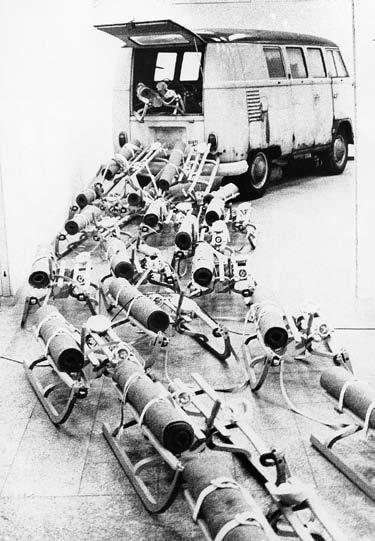
Fig.20 - Joseph Beuys. The Pack. 1969, Volkswagen bus, 20 sleds with fat, felt rolls, flashlights.
So, as an example of process art or installation, we could cite The Pack of 1969 (fig. 20), a Volkswagen bus from whose open rear door spills a number of survival sleds, each equipped with a roll of felt, fat, and a flashlight. Fond III/3 of 1979, consisting of nine large piles of felt and copper, or the much larger Stag Monument of 1982 (fig. 21), are two of many sprawling installations that perhaps could be labeled “scatter pieces.”
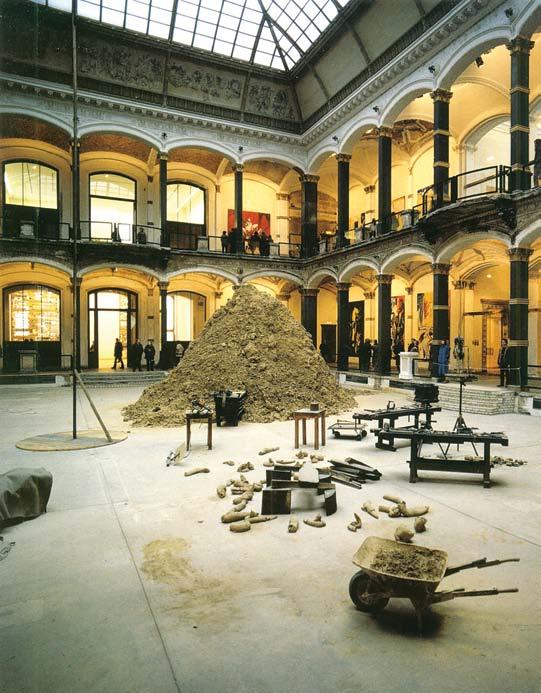
Fig.21 - Joseph Beuys. Stag Monument. 1948-1982, installation at exhibition Zeitgeist, Martin-Gropius-Bau, Berlin.
In a sense, all of Beuys’s work is “conceptual art.” Unlike most conceptual artists of the period, Beuys did not just demonstrate the possibility of conceptual art by exhibiting a pithy or witty verbal phrase, usually related to art itself, but he shaped a more complex and meaningful conceptual structure that he felt had the power to change the world. This is not to mention his presenting and working out of advanced potentials of human thinking to develop Imagination and higher powers of knowledge. Probably the clearest example of Beuys’s conceptual art are his many blackboard drawings, derived in part from those of Steiner, and used to illustrate Actions and conversations (fig. 22).
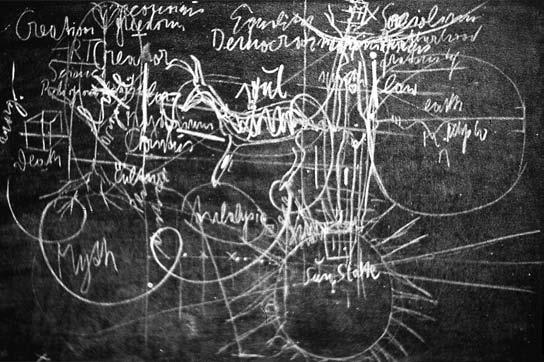
Fig.22 - Joseph Beuys. “Sun State.” 1974, blackboard drawing, Chicago.
As for earthworks, 7000 Oaks, begun in 1982 as “an ecological sign” (of the difference between dead matter and living plant), is still the largest sculpture in world. It consisted of 7,000 oak trees matched one-to-one with 7,000 tall basalt stones gathered together in Kassel, Germany, from where they were gradually placed in parallel installations all around the world (fig. 23).

Fig.23 - Joseph Beuys. 7000 Oaks. 1982 onward. Partial installation in New York City at Dia Art Center.
Some of Beuys’s works focused on exposing “trauma points” in modern materialistic social life and then attempting to effect a symbolic healing. For Tallow of 1977 he chose a “sick” spot in the town of Münster, a pedestrian underpass representing a “wound” of an ugly corner of a rectilinear building created out of the abstract thinking of modern city planning and architecture. He cast the “negative” form of this urban access ramp in a huge block composed of 20 tons of animal fat, which was then cut into 5 elements of which the largest was 78¾ x 78¾ x 118” (fig. 24). Through the warming qualities of fat, he hoped to bring a new warmth to the cold one-sidedness of the underpass, and thus effect a healing of this soulless modern urban environment by reintegrating the warm and cold poles.
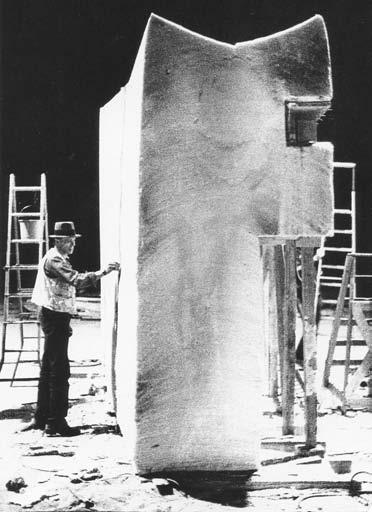
Fig.24 - Joseph Beuys. Tallow. 1977, working on 1 of 6 “fat castings.”
Despite Beuys’s widely varied artistic production, he still is probably best known for his imaginative performance pieces. As one example from his more than one hundred Actions,[33] we can consider How to Explain Pictures to a Dead Hare of 1965. This was a three-hour gallery Action for the opening of his art exhibition at Galerie Schmela in Düsseldorf. In this strange but compelling performance, Beuys sat on a stool or walked about inside the closed gallery gesturing as he silently explained his artworks to a dead hare he cradled in his arm or let touch the pictures with its paw (fig. 25). Viewers could watch through an open doorway or a window. They saw Beuys speaking to the hare, with his head covered in honey and gold leaf, a felt sole tied to his left shoe, an identical iron sole tied to his right shoe, a leg of the stool wrapped in felt, and under the stool a “radio” constructed of modern electronic parts and animal bones connected to an amplifier. The felt was made of hare’s fur and carried a warming, insulating and/or infiltrating effect. The felt sole was attached to the more inner, receptive left side of his body, while the sole made of hard, masculine iron was attached to the more active, outwardly-oriented right side.
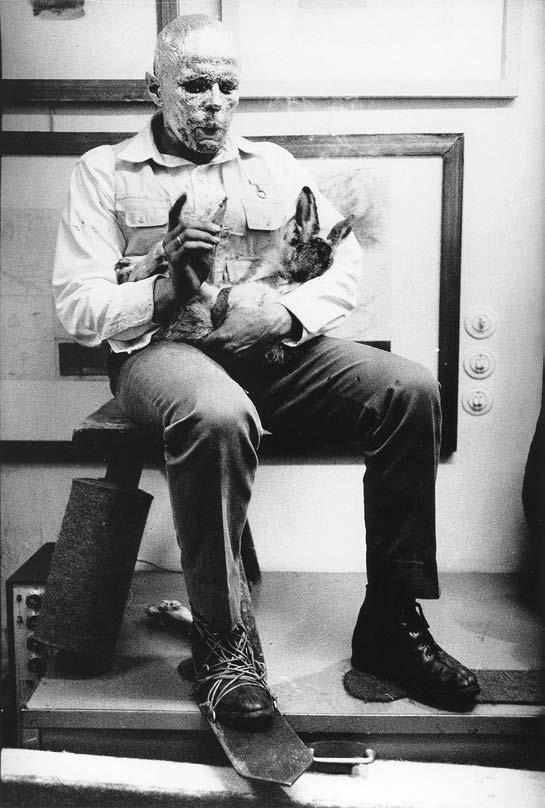
Fig.25 - Joseph Beuys. How to Explain Pictures to a Dead Hare. November 26, 1965, performance in Düsseldorf.
The Action raised questions about the possibilities of adequately explaining art or the world and about what capacities would be necessary for real understanding. Beuys commented: “Using honey on my head I am naturally doing something that is concerned with thought. The human capacity is not to give honey, but to think — to give ideas. In this way the deathlike character of thought is made living again. Honey is doubtlessly a living substance. Human thought can also be living.”[34] Gold is the metal of the sun, and Beuys was also indicating the potential for bringing a sunlike quality into thinking, a Christ-related human potential Steiner had spoken about. The hare, which literally digs into matter, represented the sharpened materialistic thinking of modern science that now needed to be filled by living intuitive thinking. The fact that the hare was dead, recalls the deathly qualities of modern abstract, scientific thought. Beuys spoke to an externalized part of himself (representative of all human beings), re-enlivening and reintegrating the dead thing that now existed outside himself as “object.” At the same time, the hare represented a still authentic spiritual power alive in the animal world that human beings have largely forgotten. “The idea of explaining to an animal conveys a sense of the secrecy of the world and of existence that appeals to the imagination. . . . even a dead animal preserves more powers of intuition than some human beings with their stubborn rationality.”[35]
Social Sculpture
Beuys also always pursued art within the context of Steiner’s ideas on the “threefold social organism,” which he promoted tirelessly through both his artistic and political activities. This is the conception of society organized into three independent areas, each with its own fundamental principle: freedom in the culturalspiritual sphere, equality in the political-legal sphere, and cooperation (“brotherhood”) in the economic sphere. Beuys commented:
This was part of Beuys’s radically broadened concept of art itself, his compassionate version of postmodernism as “social sculpture.” At times he began to speak of an “ecological Gesamtkunstwerk” (total work of art), to be created through the democratic participation of all citizens in reconstructing “a social organism as a work of art.”[37] His solution to the riddle of the work of art is the end of modernism and the development of a new concept of art as social art, where every person recognizes him/herself as a creative being with powers of thinking, feeling, and willing—as well as their more highly developed forms—and participates in the reshaping of the world out of the free, self-conscious ego.
Yet Beuys’s last work, an installation in London from 1985 titled Plight, seems somewhat pessimistic (fig. 26). It can be read as an image of the modernist isolation (by rolls of felt insulation) of culture and art (represented by the piano) from the rest of the contemporary social world. A thermometer on the piano records the temperature of artistic activity in relationship to the rebalancing warmth forces so needed by modern society.

Fig.26 - Joseph Beuys. Plight. 1985, installation at Anthony d’Offay Gallery, London.
As his own original contributions to art and culture, Beuys once cited his “totalized,” “anthropological” understanding of art—the ideas that everyone is an artist, that one can be a formcreating artist already in thinking or in speech, that art expanded to life as ”social sculpture” is what is needed in our time, and also that this creative intelligence of the people, this enlarged art, is the real capital of an economy. His primary purpose was always to stimulate social and spiritual reform, and he used new contemporary art forms as his means for bringing this message in ways that he hoped would reach people more deeply than purely intellectual dialogue and hopefully motivate them to get creatively involved in changing themselves and their world. His example still stands as a suggestive, alternative way of working artistically out of anthroposophical inspiration within a postmodern cultural climate.
David Adams, PhD,
has published and taught about art history at various state universities and art schools for 30 years and at Sierra College in California since 1996. He taught in Waldorf schools for nine years and is a member of the Council of the Art Section of the School of Spiritual Science in North America. Contact: ctrarcht@nccn.net
Endnotes
1. Jesaiah Ben-Aharon, The Spiritual Event of the Twentieth Century: An Imagination (London: Temple Lodge, 1993).
2. Clement Greenberg, “Modernist Painting,” Arts Yearbook 4 (1961), pp.
103-104; as cited in Irving Sandler, Art of the Postmodern Era (Boulder, CO: Westview Press, 1998), p. 2.
3. Rudolf Steiner, Colour, trans. John Salter and Pauline Wehrle (London: Rudolf Steiner Press, 1992), p. 127; for a different translation see The Arts and Their Mission, trans. Lisa D. Monges and Virginia Moore (Spring Valley, NY: Anthroposophic Press, 1964), p. 31.
4. The Sensible-Supersensible and Its Manifestation in Art (manuscript translation; Emerson College Library, Forest Row, East Sussex), p. 20; differently translated by Catherine E. Creeger in Michael Howard, ed. Art as Spiritual Activity: Rudolf Steiner’s Contribution to the Visual Arts (Hudson, NY: Anthroposophic Press, 1998), p. 207.
5. Ad Reinhart, in Ad Reinhart, exhibition catalog (New York: Betty Parsons Gallery, 1947), n.p.; as cited in Sandler, Art of the Postmodern Era, p. 46.
6. Robert Morris, “Notes on Sculpture: Part I,” Artforum (February 1966): pp. 43-44.
7. Clement Greenberg, “Recentness of Sculpture,” in Maurice Tuchman, ed., American Sculpture of the Sixties (Los Angeles: Los Angeles County Museum of Art, 1967), p. 25.
8. Carl Andre, quoted in Barbara Rose, “ABC Art,” Art in America (OctoberNovember 1965): 67.
9. Clement Greenberg, “Modern and Post-Modern,” Arts Magazine (February 1980): 65.
10. In addition to Daniel Bell’s related earlier books, The Coming of PostIndustrial Society (1973) and The Cultural Contradictions of Capitalism (1976), probably the earliest full statement of this aspect was the influential book by Jean-François Lyotard, The Postmodern Condition: A Report on Knowledge (Paris 1979; English translation: Minneapolis: University of Minnesota, 1984).
11. Michael Fried, “Art and Objecthood,” Artforum (Summer 1967): 12-13.
12. For short overviews of the various forms postmodern visual art has taken (at least through the early 1990s), see Charles Jencks, What Is PostModernism? (New York: St. Martin’s Press, 1986) and Eleanor Heartney, Postmodernism (Cambridge: Cambridge University Press, 2002). For a much more detailed account, see Sandler, Art of the Postmodern Era.
13. Robert Morris, “Anti-Form,” Artforum (April 1969): 30-33.
14. Robert Morris, “Notes on Sculpture, Part 4: Beyond Objects,” Artforum (April 1969): 50-54.
15. “The Two Sources of Art: Impressionism and Expressionism,” in Howard, ed. Art as Spiritual Activity, p. 211.
16. “Truth and Verisimilitude in a Work of Art,” Dramaturgische Blätter,” supplement to Magazin für Literatur (August 1898); translation in The Forerunner 3, 1 (Spring 1942): 1-6.
17. “Raphael’s ‘School of Athens’ and ‘Disputa.’” Lecture of May 5, 1909 (manuscript translation; Rudolf Steiner Library, Ghent, New York); my italics.
18. Ways to a New Style in Architecture, (New York: Anthroposophic Press, 1927), p. 9.
19. Lectures to Teachers (report by Albert Steffen of 1921 lectures; London: Anthroposophical Publishing Co., 1931), p. 79. For more on this theme, see my “Dissolving the Cartesian Threshold: Anthroposophical Art, Postmodernism, and the Reunion of Art and Society” in Art Section Newsletter 24 (Spring-Summer 2005): 17-24; and my five-part article, “Showing Off: A Critical Review of the History of Exhibition of Art,” Art Section Newsletter 25 (Autumn-Winter 2005): 7-9; 26 (Spring-Summer 2006): 32-36, 41; 27 (Autumn-Winter 2006): 20-21; 28 (Spring-Summer 2007): 19-23.
20. The History of Art. Lecture IV of November 15, 1916 (manuscript translation; Rudolf Steiner Library, Ghent, New York), p. 1.
21. “Technology and Art,” Golden Blade (1959): 8;. The same thought is expressed in The Balance in the World and Man. Lucifer and Ahriman (North Vancouver, B.C.: Steiner Book Centre, 1977), pp. 28-29; my italics.
22. The Mission of the Archangel Michael, (New York: Anthroposophic Press, 1961), p. 47.
23. Questions and Answers after The Inner Nature of Music and the Experience of Tone (Spring Valley, NY: Anthroposophic Press, 1983), lecture of September 3, 1920 (manuscript translation); my italics.
24. Speech and Drama (London: Anthroposophical Publishing Company, 1960), p. 325.
25. The Being and Meaning of Illustrative Art, p. 16.
26. See my “Dissolving the Cartesian Threshold”; my ““Philosophical Similarities between Anthroposophy and Postmodernism as a Basis for a Socially Effective Anthroposophical Art,” Jahrbuch für Schöne Wissenschaften (Dornach: Verlag am Goetheanum, 2006), pp. 371-376; Douglas Sloan, “Introduction” to Revisioning Society and Culture: Classics from The
Journal for Anthroposophy 77 (Spring 2007): 5-40; and sections of Andrew Welburn, Rudolf Steiner’s Philosophy and the Crisis of Contemporary Thought (Edinburgh: Floris Books, 2004) such as pp. 17-26, 35-46. And 57-58.
27. Questions and Answers after The Inner Nature of Music, lecture of September 30, 1920.
28. “The Meaning of Art in Ancient Times and Today,” Anthroposophical Movement (July 17, 1927): 225-32 (lecture of June 1, 1923).
29. For a more thorough treatment of Beuys’s relation to anthroposophy as well as additional information on his artistic work, see my essay “From Queen Bee to Social Sculpture: The Artistic Alchemy of Joseph Beuys,” printed as an afterword in Rudolf Steiner, Bees (Hudson, NY: Anthroposophic Press, 1998), pp. 187-213; I have also drawn on this essay for parts of this summary of Beuys’s work.
30. Joseph Beuys, in Götz Adriani, Winfried Konnertz, and Karin Thomas, Joseph Beuys: Life and Work (Woodbury, NY: Barron’s Educational Series, 1979), p. 257.
31. Joseph Beuys, quoted in Filiberto Menna, “Encounter with Beuys,” Nov. 1971, handout, Ronald Feldman gallery, New York, 1971, p. 7; as cited in Sandler, Art of the Postmodern Era, p. 15.
32. Joseph Beuys (1979), in Carin Kuoni, comp., Energy Plan for the Western Man: Joseph Beuys in America (New York: Four Walls Eight Windows, 1990). p. 19; also in Caroline Tisdall, Joseph Beuys (New York: Thames & Hudson, 1979), p. 6.
33. These Actions are covered comprehensively in photographs and descriptions (in German) in Uwe M Schneede, Joseph Beuys: Die Aktionen (Ostfildern-Ruit bei Stuttgart: Verlag Gert Hatje, 1994).
34. Adriani, Konnnertz, and Thomas, Joseph Beuys, p. 132.
35. Tisdall, Joseph Beuys, p. 105.
36. Interview with Jean-Pierre Van Tieghem, February 5, 1975, in Joseph Beuys (Brussels and Paris: Galerie Isy Brachot, 1990), p. 26.
37. Quoted in Johannes Stüttgen, Zeitstau: Im Kraftfeld des erweiterten Kunstbegriffs von Joseph Beuys (Stuttgart: Urachhaus, 1988), p. 150.










